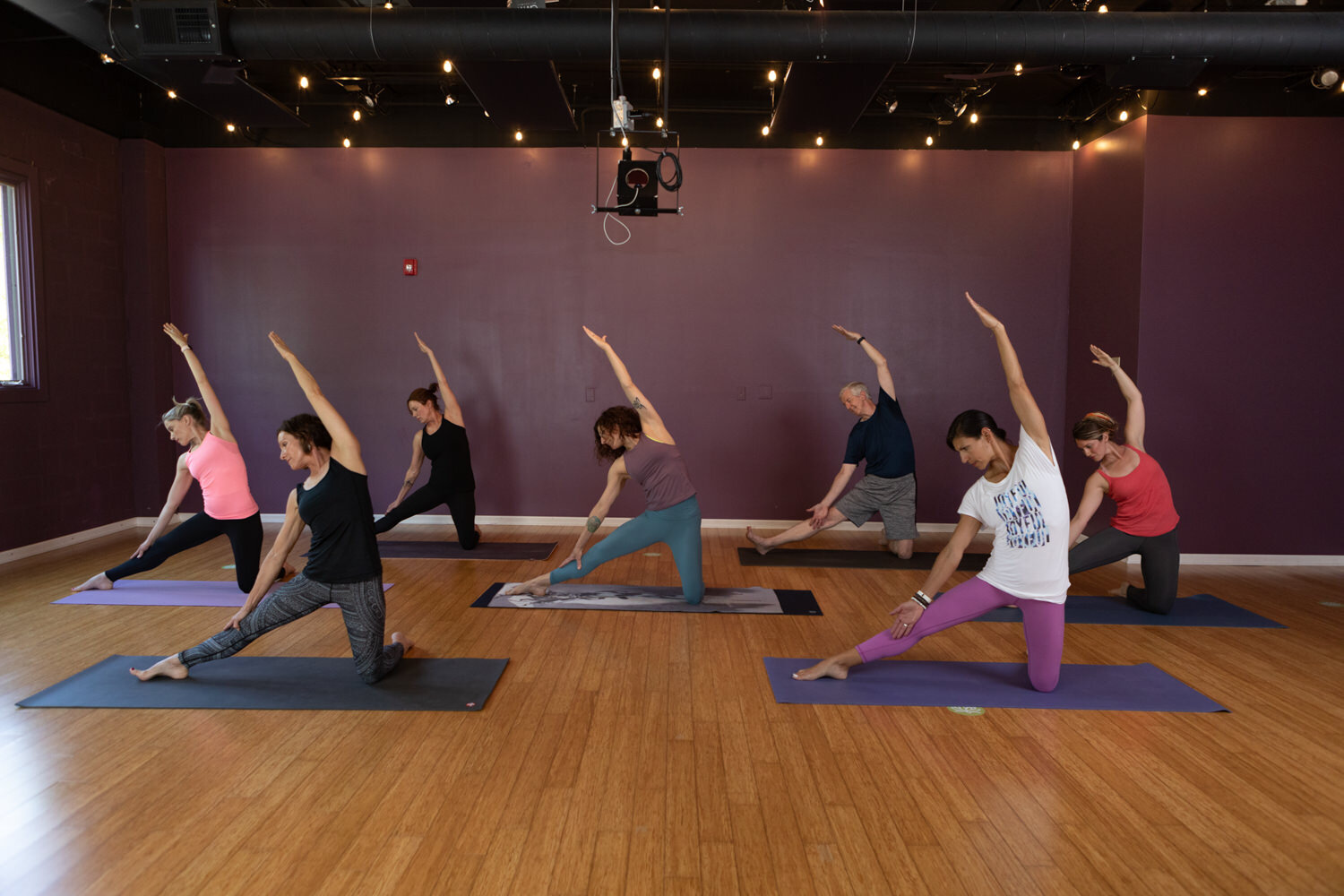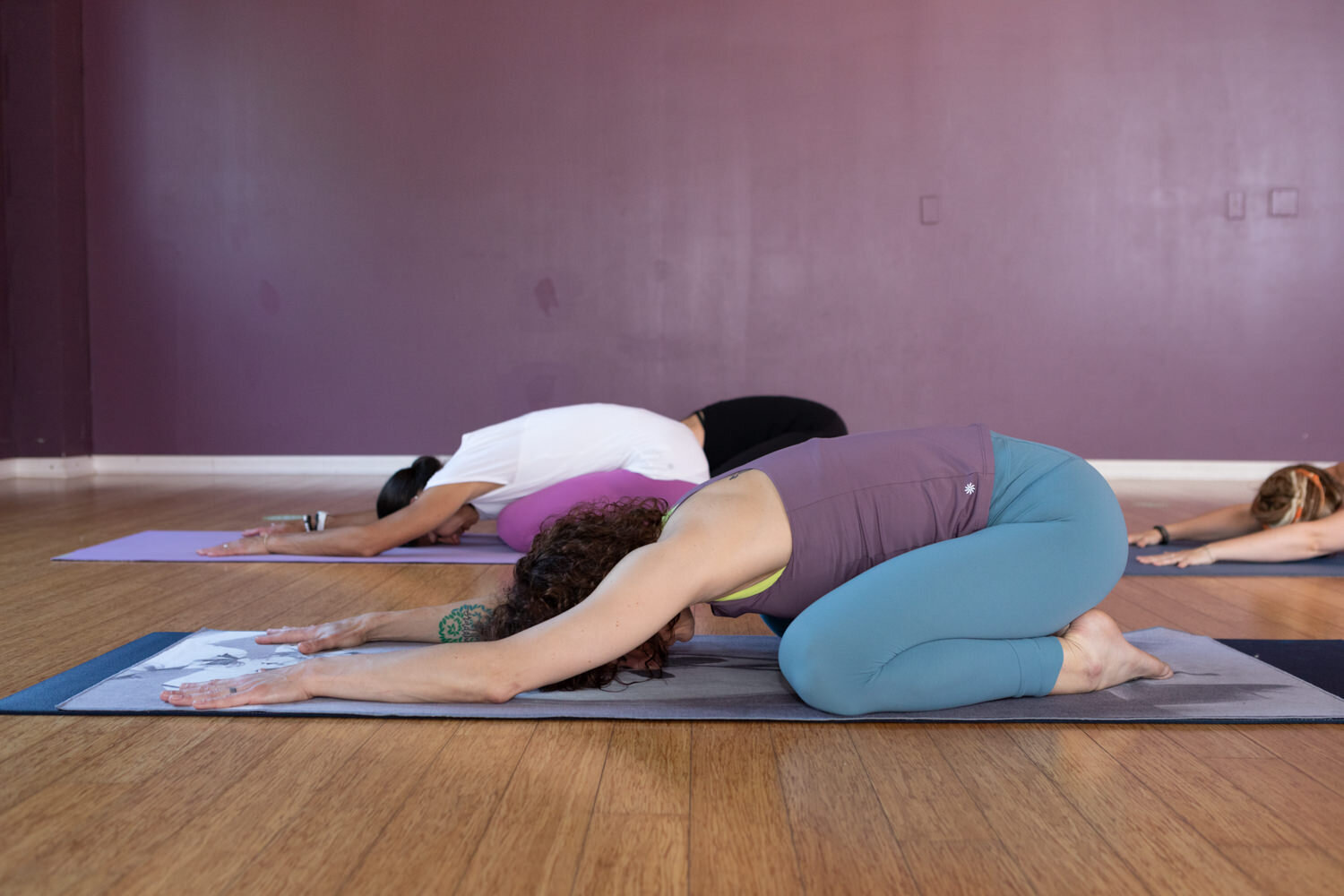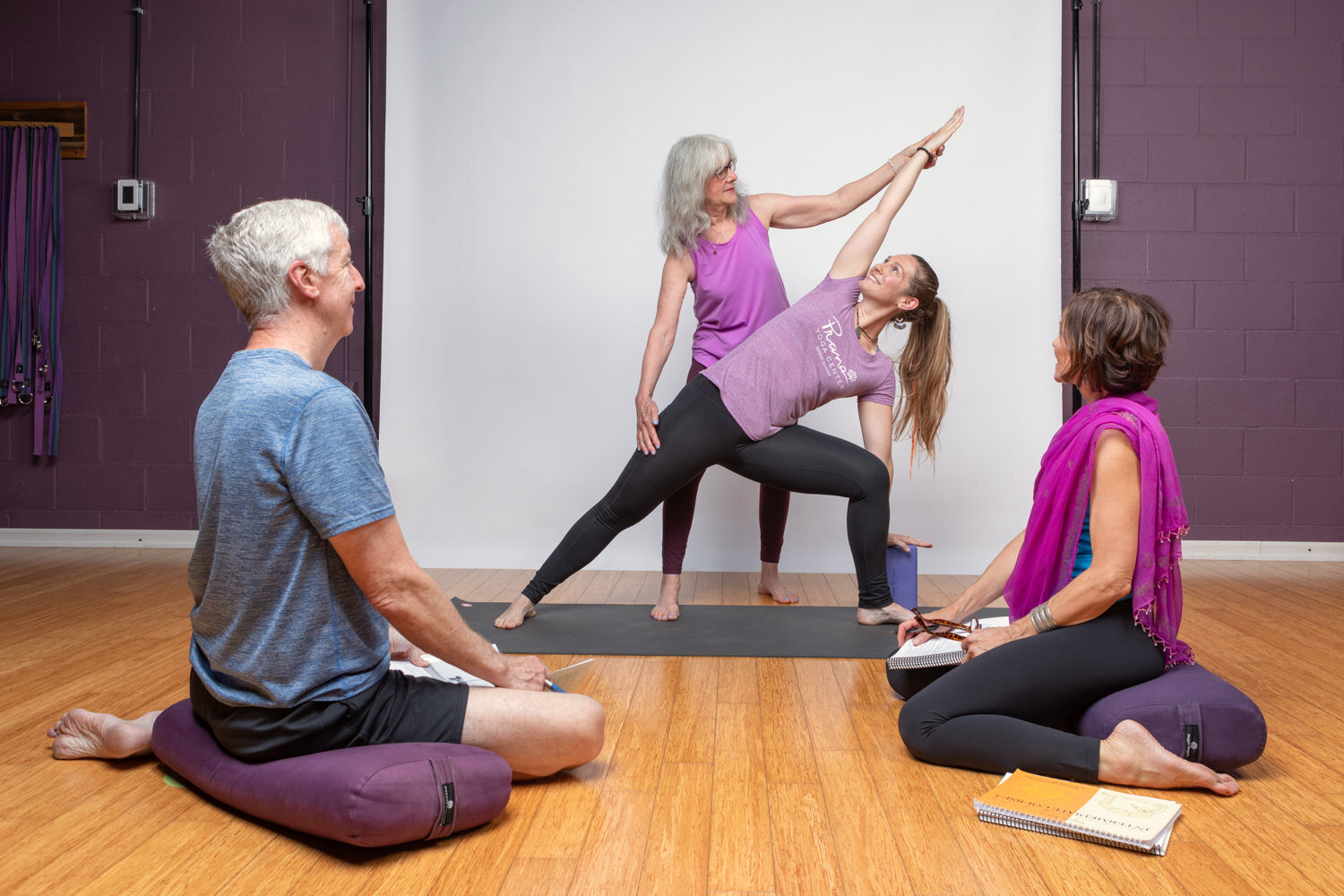
Frequently asked questions
General Questions
+ What should I wear to yoga class?
Wear comfortable athletic clothing that allows you to move freely. Come hydrated and bring water to drink water after class. Since yoga is best practiced on an empty stomach, eat lightly and cleanly 2 to 3 hours before class begins. Tell your instructor about any injuries that may require modified poses. Please arrive 10 minutes early for your first class.
+ What class is right for me?
We recommend trying several classes to find which style and instructor best suits your body and your intention for your yoga practice. There are many styles of yoga. Some styles are fast paced, others vigorous and others gentle and slow moving. View our class styles for more information.
+ Do I need to bring a yoga mat?
Yes, at this time we recommend you purchase your own mat for health, hygiene, and the feeling of practicing on your own mat.
+ What can I expect from a typical yoga class at Prana?
Each yoga style and teacher offer a unique experience. Classes typically begin with seated poses to stretch & warm the body, and create an awareness of the breath (pranayama). You will then be led through a series of postures (asanas), according to the class level. Some classes use props like straps and blocks to help deepen and support the pose. Class ends with several minutes of final relaxation: savasana or resting pose which allows time for the mind-body integration to process- don’t rush this part.
+ What is the difference between the yoga styles?
Most modern yoga styles are rooted in the classical Hatha yoga tradition. The variation in class styles depends upon how the poses are sequenced, how long they are held, and the vigor of the practice. Give yourself a few weeks and a handful of classes to find the teaching and yoga style that best suits you. Your preferences may evolve over time.
+ Will there be guidance during class?
Generally, there is little dialogue in a yoga class but our teachers will offer verbal cues and adjustments to ensure your safety or help you go deeper into the pose and to connect new neuro-muscular pathways.
+ What is Savasana?
Savasana is the final resting pose or meditation at the end of each class. It provides the time your body needs to absorb the benefits of physical practice. It allows your heart rate to slow and your mind to center. Racing out of a yoga class without time to adjust can defeat the purpose of the practice. Savasana is your moment of completion.
+ Safety Measures and Hours
We open 15 minutes before and after each class and the front door is locked at the start of each class. We have a back entrance, with ample parking, and the rear entrance door will remain unlocked if you are running late for class. The back parking lot has 24 hour security cameras around the entire building.
At Prana Yoga Center your health is our top priority! Our center is cleaned daily with Benefect hospital-grade botanical disinfectant and have Surgically Clean Air purifiers in our practice space that are used by medical systems and professional athletic organizations.
+ What if I have a new injury?
Yoga is a healing practice and mindful movement helps the body recover. Talk with your teacher at the beginning of class about your injury and share any restrictions from your medical care provider. An injury is a learning experience. Take responsibility for your body. Listen and respond when it tells you to take it easy or stop.
+ Will Yoga change my life?
It can! A commitment to a weekly practice will help you manage your stress, build confidence, strengthen your body, and deepen your inner awareness. The more you practice, the more results you are likely to see. Some experts say the practice begins to do its greatest work around the 2nd year and your practice gets better with age since the effects of yoga are cumulative. We recommend 2 classes a week to support your growth on the path.
+ How do I cancel my Membership?
You can cancel your membership anytime from your Momence account. We do not offer refunds. To avoid being charged, cancel at least 3 days before your billing period renews.

After years of not practicing yoga, I'm so happy I found Prana Yoga Center! The instructors are friendly & knowledgeable. The studio space is clean & inviting. I love the variety of classes & workshops they offer, and the fellow students are great as well.”
—Samantha
Questions About Practicing Yoga
+ How to Practice Yoga
Yoga is typically performed in bare feet on a sticky yoga mat with optional yoga props. The yoga movements and poses require clothes that can stretch and move freely with your body.
+ Your First Yoga Practice
We recommend that you start with a short and straightforward yoga session and slowly build up from there. Once you feel comfortable with a few basic beginner yoga postures, you can incorporate them into a sequence and continue to add more challenging poses.
+ How Often Should I Do Yoga?
If you can practice yoga 3 or more times per week, you will see significant improvements in your flexibility, range of motion, strength, balance, inner peace, and overall well being. Ideally, we recommend shorter and more frequent sessions, 20-45 minutes long, and for a total of 3-4 hours spread over several days. Practicing yoga less than this amount will still be beneficial, but you will see smaller improvements over a longer period of time. Like most things, the more time you can dedicate towards it, the more benefits you will receive.
+ The Benefits of Practicing Yoga
The benefits of yoga are almost endless! Practicing yoga helps build healthy virtues and good values, such as discipline, honesty, devotion, self-inquiry, mindfulness, and non-attachment. Yoga empowers you to make conscious choices toward living a more healthy and fulfilling life.
Yoga also helps you: Keep your mind healthy and strong
- Reduce stress and promote relaxation
- Get a better night’s sleep
- Boost your immune system
- Help heal common aches like back pain
- Increase happiness and well being and reduce depression
- Lose weight and change your body shape
- Improve and maintain the health of muscles, joints, and organs
- Prevent conditions such as diabetes, heart disease, and auto-immune disorders
- Improve flexibility, strength, stamina, mobility, range of motion, and balance
+ How to Improve After Starting
Patience, commitment, repetition, and consistency are the keys to developing and progressing in the practice of yoga. After you’ve found a style, teacher, and yoga studio that works for you, try these tips:
- Commit to a regular schedule of yoga classes or home practice
- Increase the length of your practice and the number of days per week that you practice
- Attend yoga workshops that focus on specific aspects of yoga in more detail
- Journal the effects a consistent yoga practice has on your body, mind, and heart
- Read and study to learn more about yoga
- Find sources of inspiration
- Make yoga friends and get involved in a community of yogis

Beginner Yoga Student Tips
+ Find a quality teacher
An experienced yoga instructor can provide a great deal of insight and guidance as you practice. A qualified yoga teacher can answer your questions during your class, as well as help you achieve the proper posture for each pose with individualized cues and hands-on adjustments. A great teacher should be knowledgeable yet kind, friendly, and compassionate.
+ Learn some terms/poses ahead of time
Many of the asanas or poses can feel complicated, especially at first. Luckily, you can spend some time before your first class getting accustomed to the poses that you can expect to perform, such as Mountain pose, Child, Warrior 1, Sun Salutations, and so on. By learning a few of these beginner poses, you’ll feel more confident and ready to take part in your class.
+ Wear comfortable clothing
The right clothes can make a world of difference in class. Ideally, you’ll want to select a supportive top and yoga pants made from breathable materials with moisture-wicking features. For cooler weather, you may want to invest in thermal athletic gear you can easily layer to stay warm.
+ Modify for your body and needs
Particularly at the beginning, it will be difficult to accomplish every pose covered in your class. If you find that you’re having trouble, your instructor can help you find ways to make it easier on your body. Don’t be afraid to use blocks, straps, or blankets to make the practice easier for your body.
+ Begin where you are
Yoga is a transformative journey meant to lead you towards some type of goal, whether that goal is less stress, better health, or inner peace. Knowing where you are can help you know where to begin and take your first steps towards your goal. Consider reaching out to a local studio for recommendations and guidance for your level of experience and fitness.
+ Avoid making comparisons
Because yoga is your own journey, there is no point in checking out someone else’s progress for the sake of comparing and judging yourself to them. You can draw motivation, appreciation, and inspiration from their bodies’ capabilities; however, don’t beat yourself up if you aren’t at that point yet. Regular practice will help you get there.
+ Go slow
Don’t rush yourself through each pose or the class. Yoga is purposeful, mindful, and fluid. By moving slowly, you can continue to make sustainable progress as you practice. Also, it can help prevent injury, boost your mindfulness, and improve your overall concentration.
+ Focus on your foundation
Much like the foundation of a building, your hands and feet form the foundation of your body. Your body depends on having a strong and steady foundation to properly hold the poses. Pay attention to the way your hands and feet are positioned and spread your fingertips and toes to build a firm base of support.

Beginner Yoga Practice
+ Maintain a regular yoga practice
Frequent short practices will be more effective than fewer longer ones. Just a few poses for 15-30 minutes a day can have a very beneficial impact on your physical, emotional, and mental well-being. You can achieve much more benefits from a daily discipline, and you will also boost your learning and mastery of the practice.
+ Stay hydrated
Hydration is crucial, regardless of the form of exercise you’ve chosen. While it isn’t recommended to drink during yoga, there are some ways that you can stay hydrated throughout your practice. About an hour before class, for instance, start sipping a 16-ounce bottle of water. Drink another 20 ounces after you’ve finished your yoga class to replace fluids.
+ Remove distractions
Worries, to-do lists, and smartphone notifications all need to be set aside for a successful session. Write down your to-do list before your practice and turn your phone off. Shift your focus away from worries and instead focus on your breath, body, and intentions while practicing.
+ Set an intention
Setting intentions for your yoga classes can help you feel motivated to work towards your goals. An intention is a purpose for your practice, which can change for each session if you prefer. Your intention is a tool to focus your mind away from thoughts and distractions, towards feelings of peace, kindness, acceptance, or whatever else you feel is needed in your life.
+ Breathe
The flow of your breath is essential in yoga classes. By breathing slowly and deeply throughout your regular routine, you increase circulation and reduce stress while stimulating your mind and body. Yogic breathing helps reduce the risk of injury, allowing your body to relax as it moves through different poses.
+ Eat mindfully
Be mindful of your eating habits, particularly if you prefer to eat before your yoga class. If you’re hungry, a light snack can help you fuel up for your class. Many people prefer to snack on small portions of almonds, fiber-packed fruits, or sports bars. Avoid greasy or garlicky foods before your class. Try not to eat anything 2-3 hours before class otherwise you’ll feel some discomfort in poses that put pressure on your belly.
+ Respect your body’s limits
Discovering and knowing your physical and mental limits is vital to succeeding in yoga. Listen to your body as you stretch, move, and breathe. If you have trouble breathing or experience pain, adjust the pose until you can do it without struggling. Also, keep in mind that some poses shouldn’t be attempted for those with certain conditions, such as injury, pregnancy, and chronic illness.
+ Cultivate a sense of humor
Having a healthy sense of humor can help you navigate moments when you feel uncomfortable, awkward, or even embarrassed trying out new yoga poses. Keep in mind that there is no pressure to be perfect as you move through different postures. In fact, smiling and internally laughing during yoga classes can help you remain relaxed and calm which will encourage success and prevent unnecessary suffering.
+ Savor Savasana
Shavasana, the final relaxation pose, might be the most difficult posture in the class. Many of us are accustomed to being constantly active and busy, and lying still with our thoughts and feelings can be a challenging experience. Practice shifting your attention to the sensations of your body relaxing and consciously work on releasing stress and tension during the pose.

Teacher Training FAQ
+ How much proficiency do I need in my personal practice before taking the training program?
We suggest that you have a minimum of 12 months of a consistent yoga practice before enrolling in our teacher training program. We want to make sure that trainees have a basic foundation in the primary yoga postures before learning to teach.
+ What will I learn in the YTT program?
In addition to making lifelong friends and deepening your experience of yoga, you will study the following topics in depth:
- Asana – learn the safe and intelligent way to perform poses
- Alignment – with modifications, variations and the proper use of props
- Sequencing – how to design dynamic, effective and intelligent sequences for all levels, Working with different kinds of bodies/students, How to observe bodies in practice, Working with injuries and limitations, Hands on adjustments.
- Sanskrit translations, The History and Philosophy of Yoga (Yoga Sutras of Patanjali), The business of Yoga and how to be successful as a teacher
+ What style of yoga is the training program?
The program is a blend of multiple traditional styles that combine the precision of alignment-based yoga, the breath-synchronized flow of vinyasa and adaptation to the individual. You will learn and experience all 8 limbs of yoga.
+ Can I miss any days of yoga teacher training?
To receive your certificate of completion you must attend 100% of the classes to comply with the Yoga Alliance requirements. If you must miss a date, it needs to be made up in another Prairie training program or a private session with faculty.
+ How many students are typically enrolled in each training at a time?
We typically have 5-12 individuals in our training. This is a high quality program.
+ Are books and materials included in the price of the training?
The costs of books are not included in the tuition. They typically total less than $100.
+ How much time is required for homework and other outside activities?
Expect to spend between 3-4 hours a week on homework. The homework is designed to support the material covered in class and help you integrate what is presented into your own practice and teaching.
+ Will I be a certified yoga teacher?
There is a national organization called the Yoga Alliance” which “registers” teachers. You will be able to register with the Yoga Alliance after receiving your certificate of completion. By successfully completing all of the YTT requirements program you will receive your certificate of completion at the 250-Hour Level.
+ What if I don’t know if I really want to be a yoga teacher?
No problem! Our 250-hour training is ideal for those who want to delve deeper into the study of yoga, and to improve their own practice. It’s also great for students who simply want to have a transformational experience and to be a part of our thriving Yoga Community.
+ How much does Yoga Teacher Training and Certification cost? And is there a payment plan option?
$3500 if paid in full by Friday, August 20, 2021 $3750 thereafter 4.5% transaction fee added for credit card payments $150 fee for payment plans (For details contact Prana Yoga Center 630-262-9642)
+ Still Looking For Answers?
We are here to help. Please contact us and we will get back to you as soon as we can!

